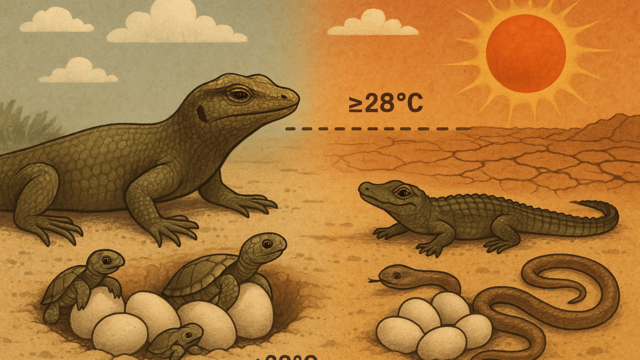- Blogs
- The Impact of Climate Change on Reptile Gender Dynamics
The Impact of Climate Change on Reptile Gender Dynamics

Waqas Abdullah
Climate change effects are soon visible, not only on lives around the world but also on the lives of animals. One particularly pervious effect is the feminization of reptiles like crocodiles, turtles and snakes. This process associated with increasing global temperatures, affects the process of natural reproduction of these species, for many of which environmental conditions are the basis for determining the sex of future offspring. Lizards depend on temperature-sensitive sex determination commonly referred to as TSD for breeding as shown by the turtles.
Males mount females and deposit sperm in the cloaca females dig holes in the sand and lay eggs which incubation is determined by the heat of the sand. According to researchers, higher temperature causes all eggs in the nest to hatch into female lizards while cooler heat means the eggs hatched are male ones. These mechanisms which are finely tuned into the natural environment are being disrupted and distorted by climate change. These variations are being brought by increasing temperatures that are scaling high proportions of females that compromise the ability of these species to reproduce. I had a problem finding specific consequences after researching for many years in different regions of the Americas to discover that areas with temperature changes appeared to be in incremental damage. In areas where temperatures are lower than 28°C most of the hatchings are male in the turtle and crocodile species.
On the other hand, in warmer temperature-started areas where the temperature range is fixed above this number, there are more females than male offspring. These results illustrate the plausibility of global climate change by linking it to distortions in the reproductive system of these reptiles. There are some implications which can be derived from this scenario. Consequently, a skewed sex ratio is one of the biggest threats to the demographic sustainability of these populations. This is dangerous to the species because, with so few males around for breeding purposes, it poses the species at risk for such extinction. This disruption impinges on individual species but also poses as great a threat to the ecosystems that identified reptiles as major predators and those crucial to maintaining the ecosystems’ functional health.
The change of the sexes of reptiles is attributed to ecological disasters that continue to occur because of climate change. Reptiles are regressive, which means that they significantly control the number of small animals in ecosystems. Its decline could also have many other effects such as this interrupting the food chain, and that habitat degradation would occur. The reduction of the number of species also lessens the vulnerability of habitats and materials to climatic variations and other changes wanted by people because the repeated ease of biological extinction weakens the delivery of many critical services of our ecosystem such as filtration of water and sequestration of carbon. To address this problem there is need for the global response to climate change.
Preventing greenhouse gases emissions is the most suitable approach to preventing temperature increase. The Paris Accord is one example of how the global population works to reduce the increase in temperature, and more needs to be done to advance the goals of these accords. The government, organization, and people need to embrace better practices and switch to the usage of renewable energy. Conservation efforts on the other hand are just as important. Measures that provide relevant reptile species nest safety and limitation of human impact in their habitats may lessen climate change influence in their reproduction. Some methods include Iowa this picture by artificially cooling their nests in order to produce a favorable sex ratio. Thus, the problem of violations of women’s rights to pee without fear and intimidation is an area that needs to be brought more to the awareness of policymakers and the communities themselves to foster support for these initiatives to make it work.
The growing process of the female sex in reptiles because of the changes in climate also makes people understand their influence on the world. This not only hurts specific species but also the general flow of the ecosystems and the need for healthy dispersity. While researchers work on capturing the extent of the problem, there is an urgent need for a multi-agency approach to the protection of other endangered species. It would therefore be important for efforts to be stepped up in the fight against climate change if these species are going to live for future generations.
Disclaimer: The views expressed in this article are solely those of the author and do not necessarily reflect the official stance of The Himalayan Research Institute Pakistan - (THRIP)
_________________________________
Waqas Abdullah is a geopolitical and strategic analyst with a special focus on Indo-Pacific politics, power patterns, and the Middle Eastern region. He is actively engaged in addressing issues related to climate refugees, displaced people, and climate advocacy, working to raise awareness and drive action on these critical global challenges.
Contact us

Write with Us
The Himalayan Research Institute is proud to introduce "Himalayan," a dynamic and insightful magazin...
- [email protected]
- +923426470466
- website
